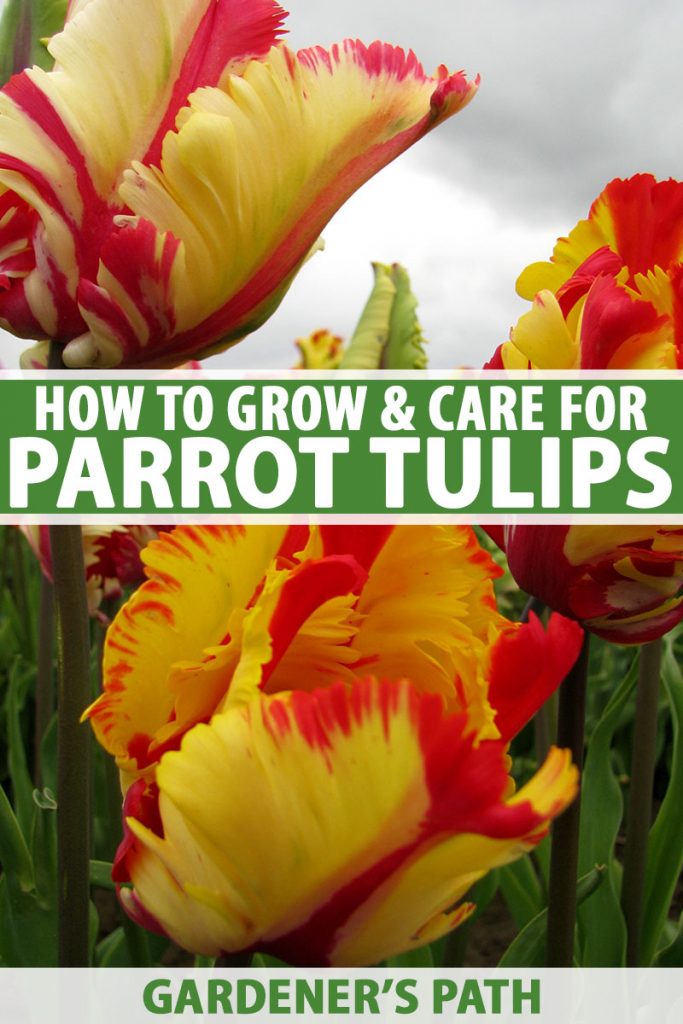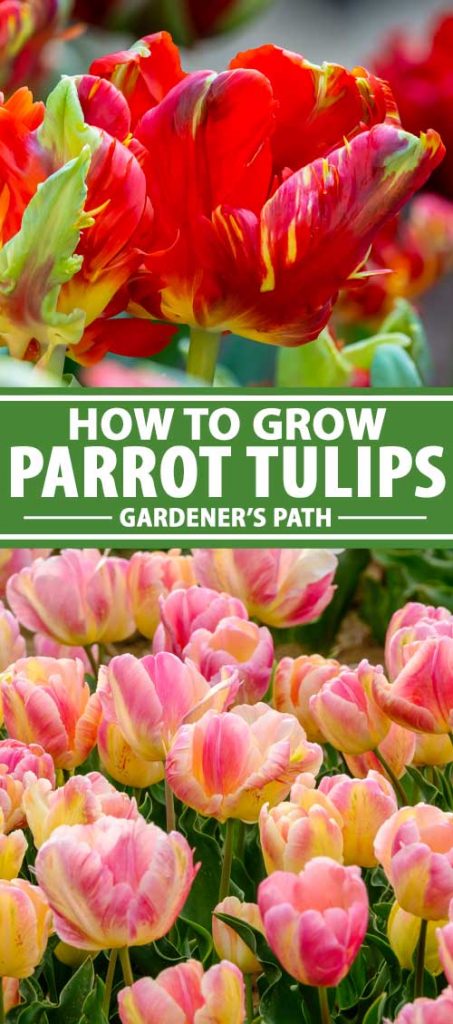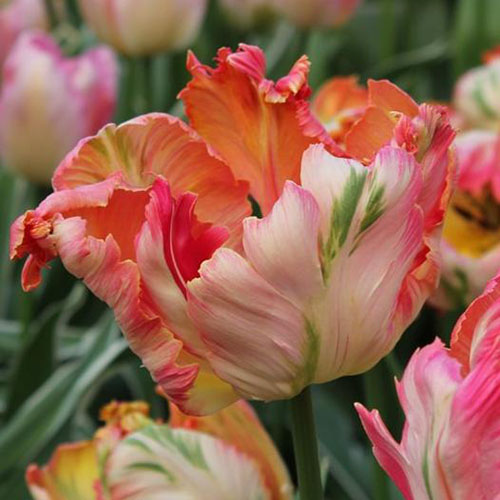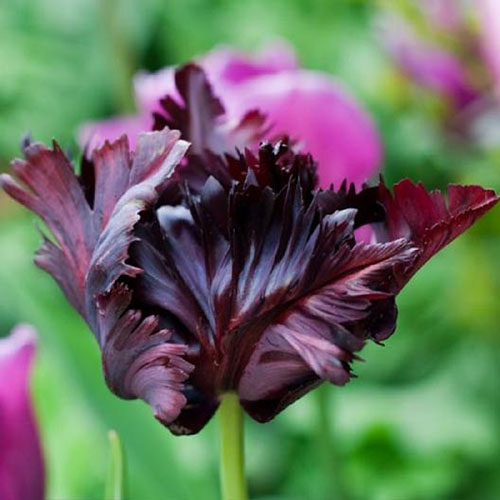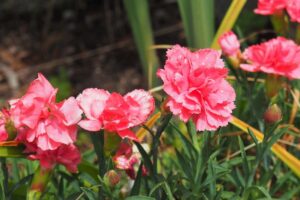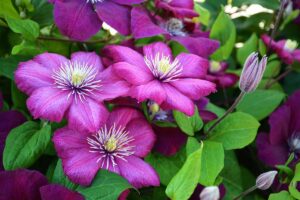Tulipa gesneriana var. dracontia
The parrot tulip, Tulipa gesneriana var. dracontia, is an intriguing cultivated variety with twisted, curled, and ruffled petals streaked by vivid combinations of colors.
We’re all familiar with tulips and their cheerful, colorful blooms that herald the arrival of spring, and the promise of warmth and sunshine.
In this article, we highlight the unique qualities of the parrot tulip, and offer tips for growing this spectacular flower successfully.

We link to vendors to help you find relevant products. If you buy from one of our links, we may earn a commission.
Let’s dive in!
What You’ll Learn
Tulip Essentials
Spring blooming tulips grow from bulbs planted in the fall in USDA Hardiness Zones 3 to 7.
Bulbs vary in size and are usually planted four to six inches deep, with two to six inches between them, in containers or in the garden.

There are many varieties available, ranging from petite four-inch botanical species to 30-inch cultivated giants. All have a four- to six-inch spread.
A full sun location is ideal, as well as average, well-draining soil with a pH of 6.0 to 7.0.
One inch of water per week is required during the growing season.
You may feed the bulbs with a balanced, slow-release, all-purpose fertilizer, such as 10-10-10 (NPK) in spring before sprouting, and again in fall.
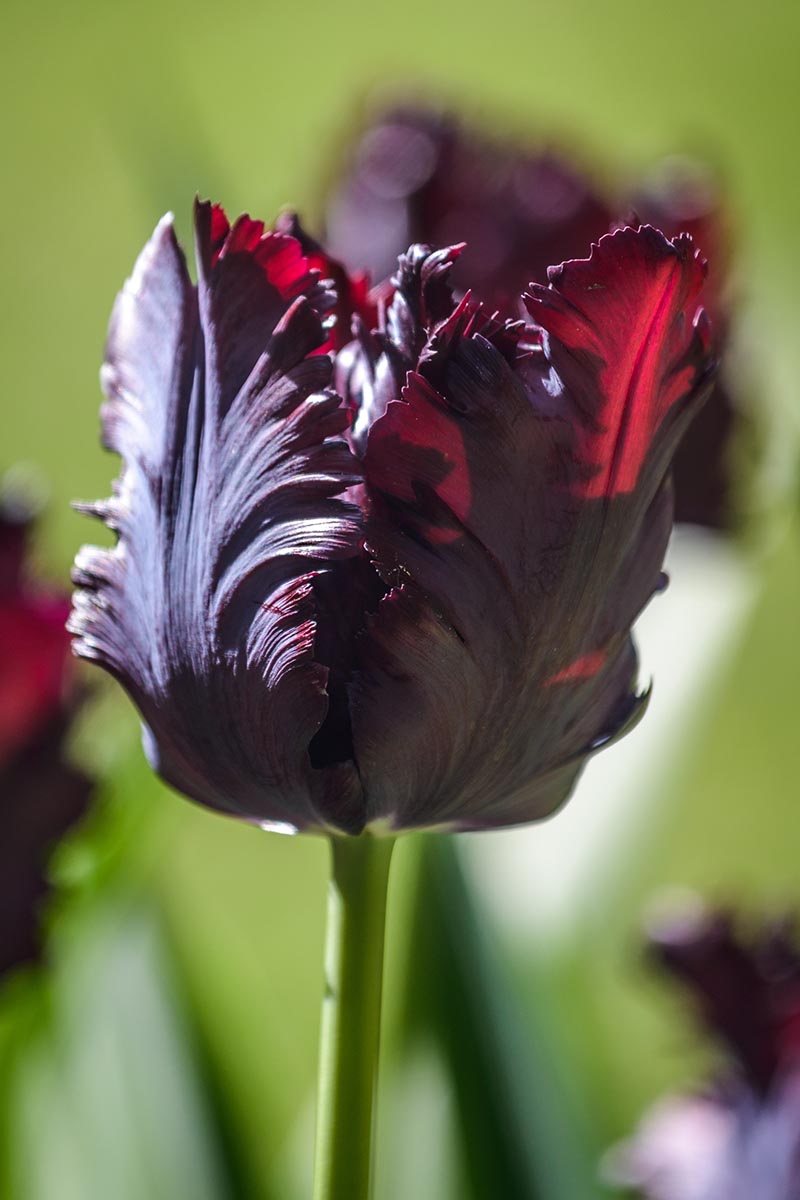
Perennials by nature, many spring bulbs are grown as annuals, because cultivated varieties often lose their vigor after the first year.
Relatively free of pests and disease, the main enemies of this plant are waterlogged soil and hungry rodents.
With these basics, you’re ready to grow.
You’ll find everything you need to know to grow and care for tulips in this growing guide, as well as an introduction to the many varieties to choose from.
So, what else do we need to know about parrot tulips?
Let’s find out!
A Majestic Mutation
The Tulipa genus traces its origins to the ancient Ottoman Empire, where these plants were retrieved from the wild for ornamental cultivation.
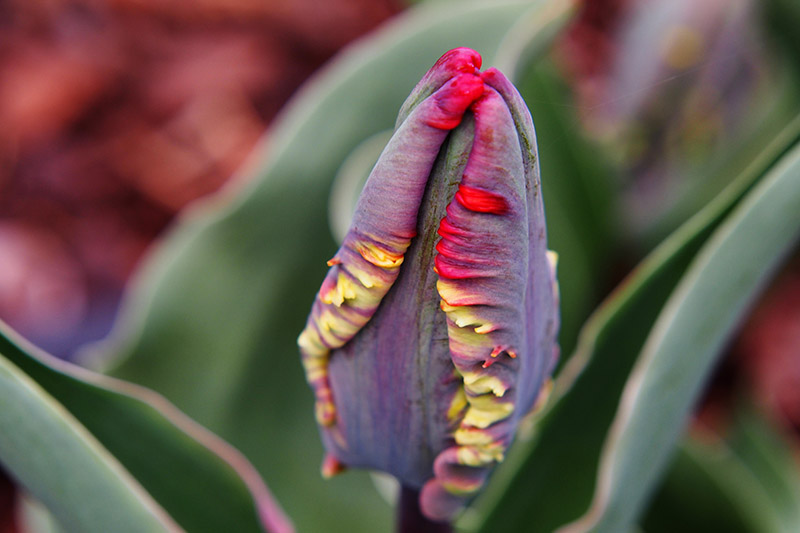
Periodically, mutations appeared with unusual qualities that sparked interest in growers.
One such aberration was due to Arabis mosaic, aka Tulip Mosaic Virus, spread by aphids. It caused random, vivid color striations across the tepals – this is the catch-all word for the inner petals as well as the outer sepals.
Another anomaly, possibly a mutation of a late-blooming variety, had the fragrant, ruffled, and striated tepals of today’s parrot, though with a weaker stem.

The highly sought after “broken” flowers contributed to a “tulip mania” in the Netherlands in the 1600s, where bulbs became more expensive than houses.
By the early 20th century, breeders had cultivated improved versions with wonderful color combinations and tepal characteristics, as well as stronger stems that would make them quite marketable.
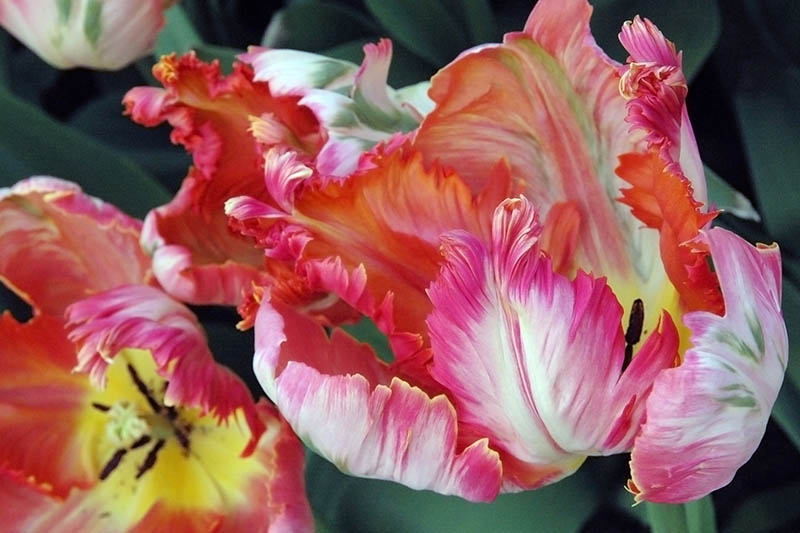
The name “parrot” is said to represent not only the flower’s “plumage,” but also its beak-like bud.
Today’s cultivars have flowers that measure an outstanding five inches across, many with stems over 20 inches tall.
Bloom time is from mid- to late spring, making these flamboyant flowers an excellent choice for interplanting with early blooming types, to extend the tulip season right up to summer.
How to Care for Parrot Tulips
The fancier types of cultivated tulips tend to be a bit more fragile than the more plain varieties, and benefit from some extra attention.

Parrot tulips are not as tolerant of temperature extremes as some varieties.
In addition, although the stems are considerably stronger than they once were – thanks to continued cultivation – they are not as tolerant of high winds or drenching rain as the tulips you may be more familiar with.

For the best results, and spectacular blooms, keep these tips in mind:
- Choose a location that is somewhat sheltered from strong winds. Avoid northern placements and consider foundation planting for the shelter a building provides.
- If heavy rain is predicted, cover your plants with large, lightweight containers if possible. Weigh them down with bricks or rocks to prevent them from damaging blooms. Upended storage tubs or even portable lawn chairs will do.
- When growing bulbs as perennials, apply two to three inches of mulch when the foliage turns brown and withers. This adds insulation against intense summer heat, as well as protection from winter cold. Remove the mulch in early spring, before they start to sprout.
We all have our quirks. In the case of these spectacular flowers, they are well worth indulging in, considering the flashy show they put on in return.
Parrot Tulip Cultivars to Love
There are more than 50 different cultivars of T. gesneriana var. dracontia, in colors that range from nearly black to orange, pink, purple, red, white, and yellow, as well as multicolored variations.
Here are some that you are sure to fall in love with:
Apricot Parrot
With oversized apricot and pink tepals streaked with green and yellow, this winner of the Royal Horticultural Society’s Award of Garden Merit is a spectacular addition to the spring garden.
Blooming in late spring, this cultivar grows to a mature height of 16 to 24 inches tall.
Find bags of 10, 20, 50, or 100 bulbs available at Eden Brothers.
Black Parrot
This deep purple, feathery-edged beauty adds a dramatic touch to the spring landscape. It’s easy to see why this variety was awarded the RHS Award of Garden Merit.
The large, almost-black flowers are lightly fragrant, and grow atop 16- to 24-inch stems.
Find bags of 10, 20, 50, or 100 bulbs available at Eden Brothers.
Victoria’s Secret
Large, bright purple blooms with a bright yellow center and fringed edges make this cultivar a beautiful addition to borders or cut flower arrangements.
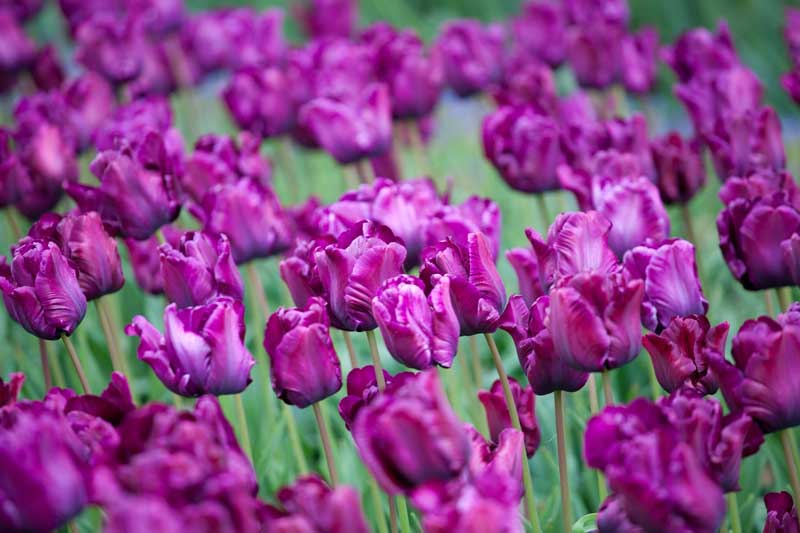
A brand cultivar released in 2021, ‘Victoria’s Secret’ grows to twenty inches and blooms in mid to late spring.
Green Wave
‘Green Wave’ adds a burst of color with flame-like blooms of green shooting up the centers of the flowers with scalloped margins of mauve and bright pink.
I don’t think I’ve ever seen a color combination so intriguing.
Blooming in mid to late spring, with a mature height of 18 inches, ‘Green Wave’ is a spectacular addition to your garden.
Quick Reference Growing Guide
| Plant Type: | Flowering bulb | Flower / Foliage Color: | All except true blue/green |
| Native to: | Middle East, Turkey | Maintenance: | Low to moderate |
| Hardiness (USDA Zone): | 3-7 | Soil Type: | Organically-rich, loose |
| Bloom Time / Season: | Spring | Soil pH: | 6.0-7.0 |
| Exposure: | Full sun to part shade | Soil Drainage: | Well-draining |
| Spacing: | 2-6 inches | Companion Planting: | Alliums, daffodils, lilies |
| Planting Depth: | 4-6 inches | Uses: | Flower garden, perennial beds |
| Height: | 16-24 inches | Order: | Liliales |
| Spread: | Up to 6 inches | Family: | Liliaceae |
| Growth Rate: | Medium | Genus: | Tulipa |
| Water Needs: | Moderate | Species: | Gesneriana |
| Common Pests and Diseases: | Aphids, Japanese beetles, slugs, wireworms; Augusta disease, botrytis, botrytis blight | Variety: | Dracontia |
Pamper Your Parrots
I know you can’t wait to add parrot tulips to your outdoor living space! Their spectacular display is well worth the extra effort required.
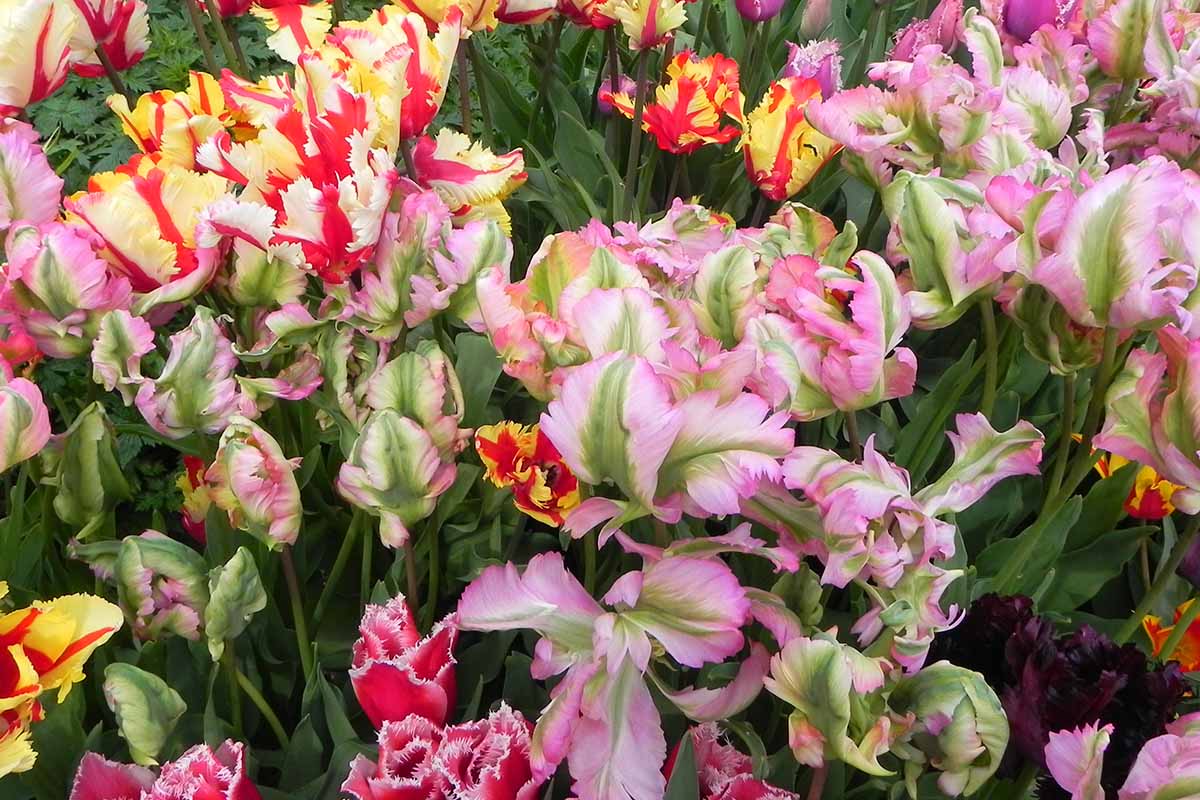
Place them in tall containers flanking an entryway, or in a foundation bed where they can show off their sumptuous blooms, and benefit from the shelter of your home.
Interplant them with hostas, leafy plants that help shield their delicate stems, and hide their fading foliage as spring gives way to summer.
If you grow them as perennials, remember to cover with mulch after the foliage dies to the ground.
As annuals, simply lift them when they’ve finished blooming, and plant new bulbs of your choice in the fall. You can change your color scheme each year, if you like.
And finally, be sure to get plenty of bulbs so you can enjoy them both outdoors and indoors. The tall, slender stems and exotic blooms take any vase arrangement to bold new heights!
Have you ever grown parrot tulips? What advice can you offer? Please tell us in the comments section below.
Looking for other varieties? Check out our “Types of Tulip Flowers: 15 Beautiful Divisions” or some of these specific tulip guides next:
